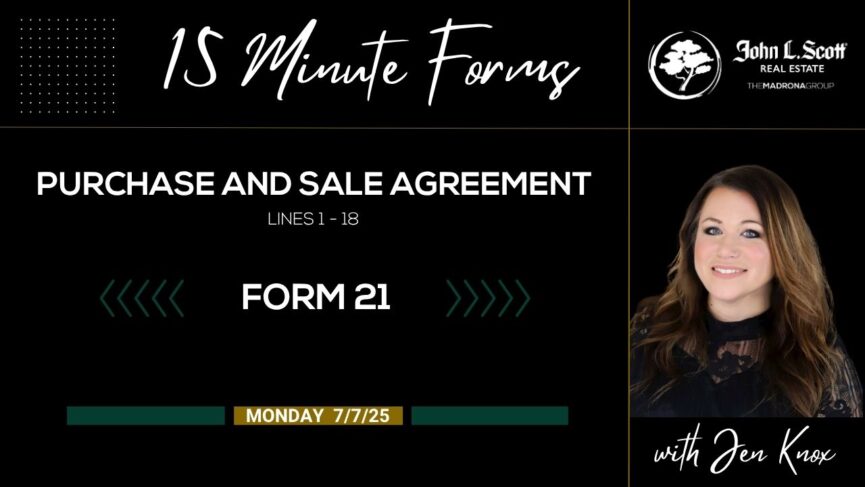“If you don’t know your contract, you don’t know your business.” — Every top broker, ever.
In the fast-paced world of Seattle real estate, your contracts aren’t just paperwork—they’re the playbook. And no form carries more weight than Form 21, the purchase and sale agreement. Whether you’re brand new to the game or have a hundred deals under your belt, there’s real value in slowing down and taking a solid look at the foundation of every deal you write.
That’s why we created this post just for Seattle-area real estate brokers—to walk you through the first 18 lines of Form 21, plus the signature lines. Because if you know what’s supposed to go where (and why), you’ll avoid headaches, impress your clients, and show up as the professional that every buyer and seller wants on their team.
Think of this as your 15-minute desk-side training with The Madrona Group—except in written form, and way easier to revisit anytime you want a refresher.
What to Expect:
- A short 15 Minute Forms training video walking you through Form 21 (Lines 1–18)
- A practical breakdown of lines 1–18 (plus the signature lines) of the purchase and sale agreement, and why each detail matters for your transaction
- Tips to help you sidestep the most common broker mistakes—like mismatched legal names, missing earnest money deadlines, unclear possession timing, and how to handle compensation requests post-NAR settlement
- A clear picture of how mastering these foundational pieces can elevate your confidence, protect your clients, and help you stand out as a go-to Seattle real estate broker
15 Minute Forms: Purchase and Sale Agreement Form 21 (lines 1-18)
1. Why Form 21 Is the Broker’s Essential Tool
Form 21 isn’t just a sheet—it’s the legal foundation for WA real estate transactions. Fill it out correctly, and you’ve built rock-solid trust. Skip one detail, and deal delays or disputes can derail your deal.
2. Lines 1–4: Dates, Parties & Property
Line 1: Contract Date
This is just the date you write the offer. Doesn’t affect when the deal actually binds—that starts at mutual acceptance.
Line 2: Buyer’s Legal Name
It must match the ID they’ll present at escrow. No nicknames—no mess.
Line 3: Seller’s Legal Name
Must align with the name on the title report. If it doesn’t match, you risk chain-of-title hiccups.
Line 4: Property Address & Tax ID
Auto-populates from NWMLS, but do a manual check. Attach the legal description from title—no “just trust the sheet” assumptions.
3. Line 5: Inclusions—Appliances & Extras
Clarify and checkbox what stays with the home. Attached or not, if it’s not in line 5, it’s not enforceable—even if it’s in the MLS. Clarity here avoids post-inspection disputes.
4. Lines 6–8: Price, Earnest Money & Remedies
- Line 6 – Purchase price: plain and simple.
- Line 7 – Earnest money: define the dollar amount and delivery timeframe. Seattle escrow holds funds by default; if wiring, add a buffer.
- Line 8 – Buyer’s breach remedy: choose between forfeiture of deposit or seller’s election. Explain both options clearly to clients—they’re not one-size-fits-all.
5. Lines 9–10: Title & Escrow Companies
Separate title and escrow? You can choose. But be aware: changing from seller’s originally opened title may push extra fees to the buyer. Essential broker knowledge when guiding your buyers.
6. Line 11: Closing & Possession
Closing date sets the deadline. Default key hand-off is 9 PM closing day, unless you note otherwise. If your client wants early move-in or late stay, use the appropriate addendum. Don’t leave this vague.
7. Line 12: Utilities & Prorations
This is what escrow uses to calculate daily credits/debits. Sellers pay until closing; buyers from closing forward. Double-check any HOA dues or municipal hook-ups—they fall here too.
8. Line 14: Seller Citizenship Disclosure
This is a disclosure-only field—not negotiable. If you’re unsure, leave it blank. Only fill it if you have documentation (FIRPTA). Seattle brokers must avoid assumptions here.
9. Line 15: Info Review Period
This isn’t an inspection right—it’s to verify HOA docs, assessor info, etc. Default is 10 days after mutual acceptance. You can waive or shorten it—but document client preferences.
10. Lines 16–17: Agency & Compensation (Post-NAR Changes)
Line 16 – Required agency disclosures: check proper boxes (buyer broker, listing broker, dual, or unrepresented).
Line 17A – Published compensation from MLS (buyer broker compensation or seller broker).
Line 17B – Requested compensation.
Note: Due to the NAR settlement and new rules, compensation is no longer automatically paid by the seller—it’s negotiated up front. Be ready to guide brokers through waivers, dual agency, and side-by-side agreements.
11. Signature Lines
Make sure each party signs under the correct capacity: “seller,” “seller broker,” “buyer,” and “buyer broker.” No overlap, no misrepresentation. Unrepresented parties should have blank broker lines.
✅ Common Pitfalls to Avoid
- Using nicknames on legal name lines
- Assuming auto-populated fields are error-free
- Overlooking non-attached items in line 5
- Skipping the remedy explanation in line 8
- Ignoring compensation negotiation post-NAR settlement
Frequently Asked Questions
Q: Can compensation be renamed or realigned post-NAR settlement?
A: Yes, post-settlement, compensation must be negotiated and confirmed—either offered in MLS or agreed upon in writing. No more default seller-paid commissions.
Q: Does line 5 need detailed descriptions of appliances?
A: Yes. To enforce inclusion, note specifics—“Samsung fridge,” etc.—so there’s no room for argument.
Q: What’s the difference between inspection and information review?
A: Line 15 allows buyers to verify property data, HOA documents, and tax info—not structural or mechanical inspections. That’s a separate contingency.
Takeaways
- Master lines 1–18 to prevent delays and disputes
- Negotiate compensation transparently in line 17 post-settlement
- Confirm everything, including details, dates, and disclosures
Final Thoughts on Form 21 the Purchase and Sale Agreement
Form 21 isn’t just the first page in a stack of paperwork—it’s where every great transaction begins. As a Seattle real estate broker, understanding the ins and outs of the purchase and sale agreement (especially lines 1–18) helps you avoid missteps, better serve your clients, and set yourself apart from the crowd. It’s not about memorizing forms—it’s about knowing why each field matters and how it can impact the deal, the relationship, and your reputation.
By taking the time to sharpen your contract skills, you’re doing more than filling in blanks—you’re stepping into the role of a trusted advisor, problem-solver, and pro-level closer. Whether you’re reworking an offer on a tight timeline or explaining earnest money timelines to a first-time buyer, a confident grip on Form 21 turns stress into strategy.
If you’re a Seattle real estate broker interested in development, training, or being part of a top-tier real estate firm, reach out to The Madrona Group today. Let’s build your contract confidence together.
Share this post!




